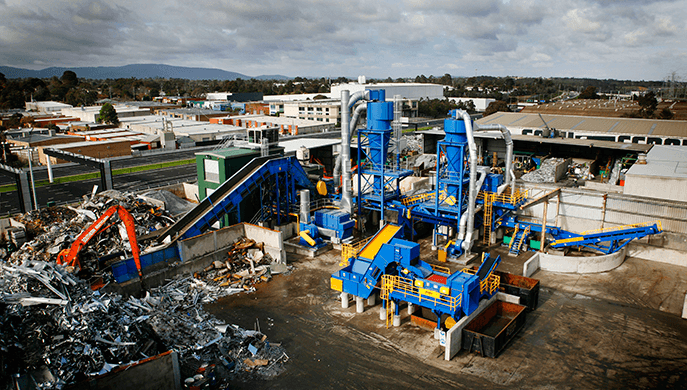Companies that operate shredders to recycle metals from autos and other scrap are increasingly coming under pressure from regulators to install air pollution control systems, and very frequently, this includes installing particulate matter control devices. The common target of regulators is the emission of fine dust particulate and ‘blue smoke,’ (i.e., oil droplets that evaporate in the heat of the shredding process and then condense in the air exhausted from the shredder as it cools). Often this particulate matter is mixed with condensed water droplets generated by water spray in the shredder and/or water contained in the material being shredded. Many shredders in service currently have no particulate matter control device installed, and among those with installed equipment, very few have equipment capable of removing the submicron particulate, which is the thermally-generated portion of the particulate matter.

Particulate matter emission limits included in air permits typically apply to the sum of both filterable (i.e., solid) and condensable (i.e., liquid droplet form, including blue smoke) particulate matter. In addition, an opacity (visible emissions) limit on the stack exhaust may also be included in an air permit for a shredding facility. Visible emissions are caused by particulate matter, and the finer the particulate matter present, the greater the visible emissions.
Due to the oily, wet, and messy nature of the particulate matter emitted from the shredder, the choices for a particulate matter control device are very limited. A cyclone is typically an effective pre-filter for removing larger particulate matter, but this device cannot capture the finer or lighter/less dense dust particles and certainly will not capture the blue smoke, which is mainly submicron in size. For capturing fine or light particulate matter, there are essentially two options—a high-efficiency (high pressure) venturi scrubber, and the Ultra High-Efficiency Filter (UHF®) unit. APC offers both of these particulate matter control devices and strongly recommends the latter for shredders.
APC has been supplying UHF® filter units as particulate matter control devices on auto shredders since 2008, with multiple filter units in service for approximately 10 years. APC is intimately familiar with both the venturi scrubber and the UHF® filter unit since it produces both types of devices. A major reason that Owners of shredders prefer the UHF® filter to a venturi scrubber is that the UHF® filter system is a dry system whereas the venturi scrubber is a wet technology, and as such the UHF® filter has no wastewater to treat or otherwise dispose of. Wastewater disposal requirements associated with venturi units vary by facility, but can be very expensive to address via local discharge fees or off-site hauling and disposal, or alternately can add substantial infrastructure requirements to add proper water treatment equipment. Venturi scrubber wastewater at auto shredder applications can be especially problematic operationally as well, as there are light/low-density solids such as fibers and foam fragments that float in the wastewater and thus are not captured in settling tanks; if this floating material is not manually removed constantly (which requires significant attention and manpower), this material will plug downstream drains, filters, and other equipment. In northern climates, freezing can be a significant issue with wet treatment technologies. The UHF® filter uses no water spray and therefore the only water it collects is water contained in the gas stream, which is a very small fraction of the wastewater generated by the wet scrubber.
Another reason that shredder Owners prefer the UHF® filter unit to a venturi scrubber is that the UHF® unit is more efficient at removing submicron particulate matter and thus can easily meet all regulatory particulate matter and opacity standards. To effectively capture submicron particulate matter, the venturi scrubber must be operated at a pressure drop of 40” WC or more, and even then it will struggle to remove particulate of size 0.3 micron and smaller. In contrast, the UHF® filter needs only 15-20”WC to capture 0.3 micron particulate matter with high efficiency. The UHF® filter therefore uses less energy and has significantly lower operating costs to achieve opacity/visible emission limits and high particulate matter removal efficiencies.
Please contact APC at 412-344-1870 or 877-464-2728 to discuss your air emission control needs.

